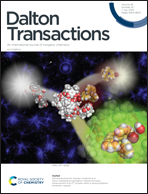Loading and release of doxorubicin hydrochloride from iron(iii) trimesate MOF and zinc oxide nanoparticle composites†
Abstract
A significant amount of work has been done in recent years for the development of metal organic framework (MOF) based drug delivery vehicles. Often, nanomaterials such as iron oxide (Fe3O4), zinc oxide (ZnO), and other metal oxides like graphene oxide etc. are incorporated into the structures to impart additional functionality. In this work, an iron(III) trimesate metal organic framework i.e. MIL-100(Fe) and its composites with ZnO nanoparticles i.e. ZnO@MIL-100(Fe) were investigated as delivery agents for anticancer drug doxorubicin hydrochloride (DOX). The synthesis of the composites was done by two routes viz. a conventional HF route (in the presence of HF as a crystallizing agent) and another one in the absence of HF. The resultant MOF and its composites significantly differ in DOX loading capacity and release rates. The results obtained in this work indicate that the DOX loading capacity increases upon addition of nanoparticles when the original MOF has lower mesopore volume (as in the sample obtained via the HF route). Surprisingly, this increase in the DOX loading was comparable to that of Fe3O4@MIL-100(Fe), although the two pure nanoparticles (ZnO and Fe3O4) have widely different loading capacities. On the other hand, the addition of ZnO nanoparticles reduces the DOX loading capacity, if the MOF has higher mesopore volume (as for the sample obtained via the HF free route). The composites synthesized by the HF route with enhanced loading capacity exhibit slower DOX release rates due to the stronger interaction of the drug with the composite.



 Please wait while we load your content...
Please wait while we load your content...